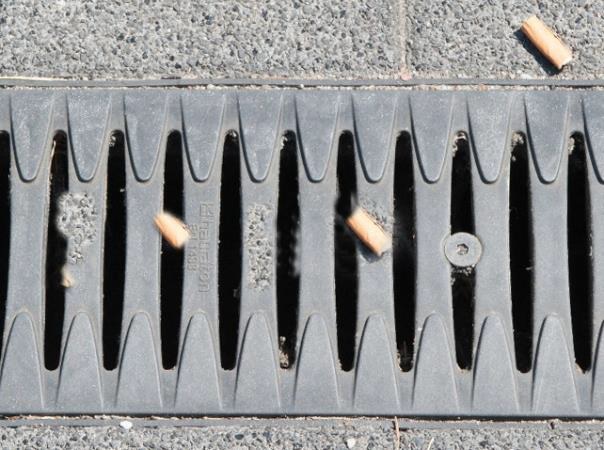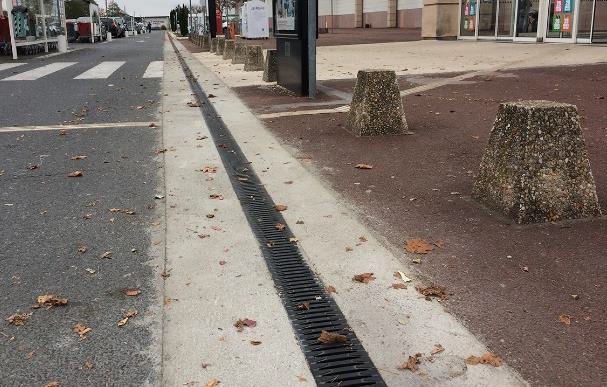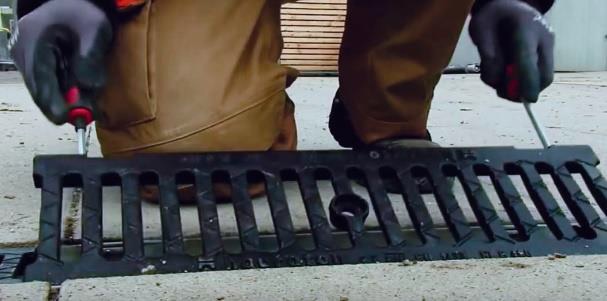
In order to ensure a high degree of hydraulic utilization, a continuously unrestricted drainage cross-section is necessary. Regular care and maintenance work of drainage systems are essential for this. Debris and other defects should be detected and removed to ensure that the drainage system functions properly.
We recommend that drainage systems are checked and maintained at least once a calendar year – preferably after the winter months – along the entire length of the channel run. The frequency depends mainly on the traffic frequency and local site conditions (e.g. use of de-icing salt, sweeping, entry of solid particles, …).
We recommend that inspection and maintenance be carried out more frequently under the following conditions:
- Cold or tropical regions with extreme climate conditions
- In dry climates, the drainage channel is often only filled with little rainwater and is therefore usually clean. The sediment accumulation must be assessed. We recommend flushing the channels regularly with clean water
- Regions with increased solid matter input (> 500kg TMges/haAu*a, due to e.g. foliage, de-icing salt use in winter operation, lack of road sweeping, …)

Cleaning Drainage Gratings
Visual inspection of the gratings:
- Check the gratings of drainage channels for mechanical damage and/or clogging by debris entry
- With bolted gratings, check that all screw and locking handle connections are properly secured
- Ductile iron gratings can show signs of corrosion. This has no effect on the functioning of the channel
Cleaning and maintenance of the gratings:
- Coarse debris and solids (e.g. cigarettes, paper, small stones) can be swept away with a broom.
- Clean the openings of the gratings thoroughly, e.g. with a high-pressure cleaner, to ensure the drainage function.
- Small stones can be removed with a screwdriver or other pointed object. Care must be taken not to damage the gratings.
Cleaning of the channel bodies and trash boxes
Visual inspection of the channel bodies and trash boxes:
- During the visual inspection of the channel base and trash boxes through the grating, a visual check must be made to see whether there is a large amount of debris in the channel base or in the mud bucket.
- The amount of debris in the channel base can be determined with the help of a folding ruler which is placed through the grating on the channel base.
- We recommend removing gratings with narrow openings (e.g. perforated grating) for a visual inspection of the channel base and trash boxes.
- An inspection camera can be used with monolithic drainage channels or slotted channels.
Cleaning of the channel bodies and trash boxes:
Drainage systems should be carefully cleaned during routine annual maintenance intervals. It is always cleaned from the drainage channel to the trash box. Before cleaning work is completed, the unobstructed flow into the trash box must be ensured.
- Taking into account the respective fastening system (e.g. locking handle, SIDE-LOCK, screw connection) the grating must be removed accordingly.
- In case of light accumulation of debris, drainage channels can be cleaned with a broom.
- Stubborn dirt can be cleaned with a high-pressure cleaner (water jet pressure up to 120 bar) by passing the cleaning water through the entire length of the channel run. It must be ensured that all sediments or deposits in the system are loosened and rinsed to the next outlet or trash boxes.
- The outlet points of the trash boxes must be cleaned during the maintenance interval. The mud buckets must be removed and cleaned. Then check whether the connected piping is draining properly.
- Before reinstalling the grating, check the angle housings and grating support surfaces and clean them if necessary.
- SIDE-LOCK boltless locking system: Simply clean the SIDELOCK nibs, grating support surfaces, and the recesses of the longitudinal slide lock with a hand brush or water jet.
Visual inspection of the environment:
- Adjacent surfaces such as paving, concrete, or asphalt should also be checked at regular intervals.
- It should be checked whether there is any damage and whether there is a permanent elevation of 3-5 mm.
Fixing the grating
Hauraton drainage systems have different grating designs and therefore also different fixing systems. The grating can be either screwed or clamped or a combination of both types of fastening.
Loosening of bolted grating:
The following tools can be used to remove the gratings.
Gratings fixed with a hexagon head screw:
- Wrench size 13 and 17
Gratings which are fixed with a hexagon socket screw:
- Wrench size 5 and 6
When reinserting grating, the maximum tightening torque should not be exceeded:
- Channels with plastic locking handle of nominal widths 100 mm and 150 mm should be tightened with four turns after the screw has been tightened.
- When screwing the grating with steel locking handles, a maximum tightening torque of 5 Nm must not be exceeded.
- RECYFIX NC – The tightening torque should not exceed 15Nm.
- FASERFIX SUPER – The tightening torque should not exceed 40Nm.
- FASERFIX KS – The tightening torque should not exceed 15Nm.






